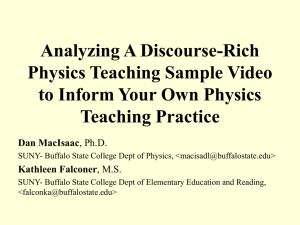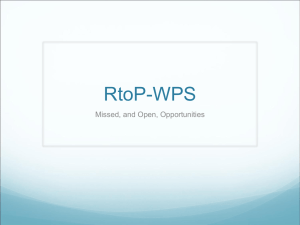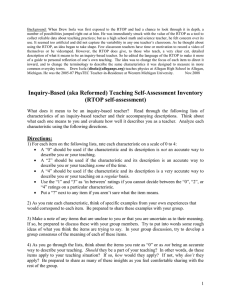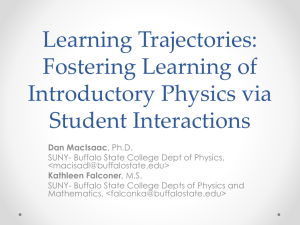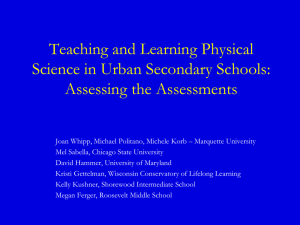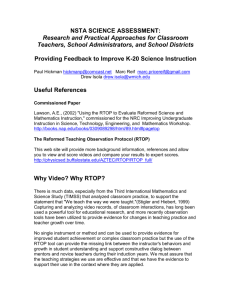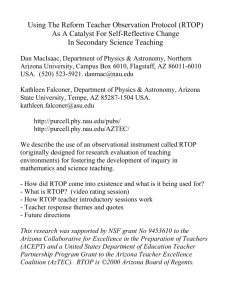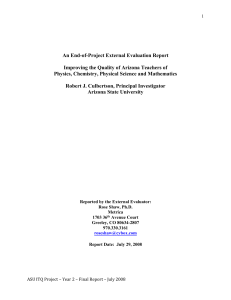Using Formative Assessment and Feedback to Improve Science Teacher Practice
advertisement
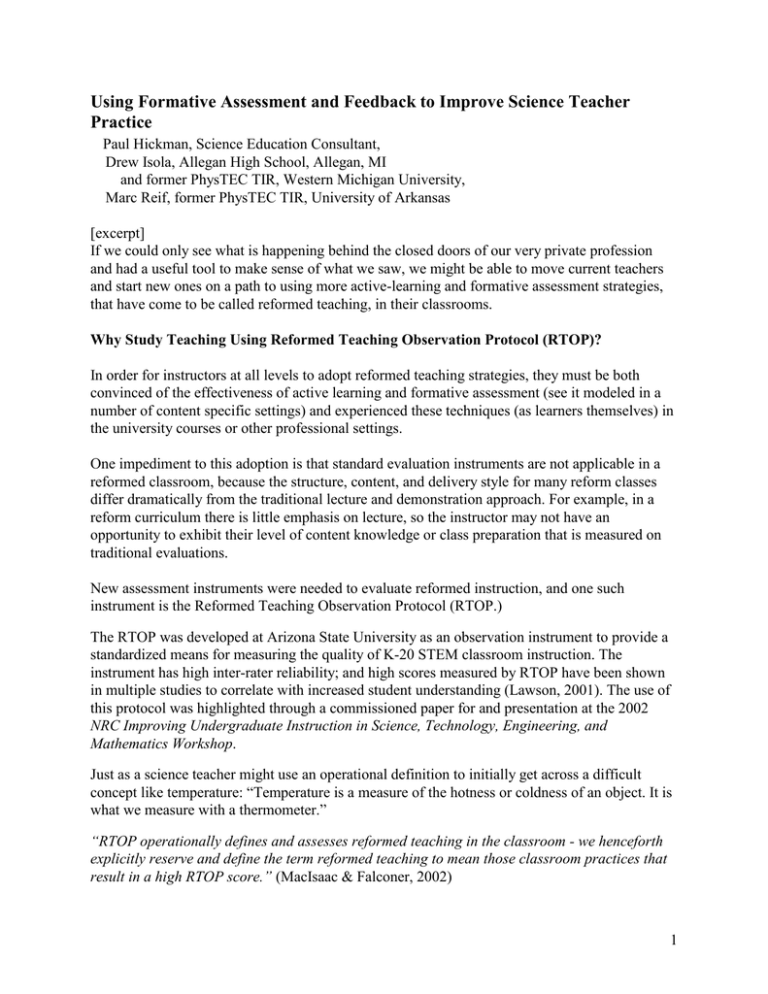
Using Formative Assessment and Feedback to Improve Science Teacher Practice Paul Hickman, Science Education Consultant, Drew Isola, Allegan High School, Allegan, MI and former PhysTEC TIR, Western Michigan University, Marc Reif, former PhysTEC TIR, University of Arkansas [excerpt] If we could only see what is happening behind the closed doors of our very private profession and had a useful tool to make sense of what we saw, we might be able to move current teachers and start new ones on a path to using more active-learning and formative assessment strategies, that have come to be called reformed teaching, in their classrooms. Why Study Teaching Using Reformed Teaching Observation Protocol (RTOP)? In order for instructors at all levels to adopt reformed teaching strategies, they must be both convinced of the effectiveness of active learning and formative assessment (see it modeled in a number of content specific settings) and experienced these techniques (as learners themselves) in the university courses or other professional settings. One impediment to this adoption is that standard evaluation instruments are not applicable in a reformed classroom, because the structure, content, and delivery style for many reform classes differ dramatically from the traditional lecture and demonstration approach. For example, in a reform curriculum there is little emphasis on lecture, so the instructor may not have an opportunity to exhibit their level of content knowledge or class preparation that is measured on traditional evaluations. New assessment instruments were needed to evaluate reformed instruction, and one such instrument is the Reformed Teaching Observation Protocol (RTOP.) The RTOP was developed at Arizona State University as an observation instrument to provide a standardized means for measuring the quality of K-20 STEM classroom instruction. The instrument has high inter-rater reliability; and high scores measured by RTOP have been shown in multiple studies to correlate with increased student understanding (Lawson, 2001). The use of this protocol was highlighted through a commissioned paper for and presentation at the 2002 NRC Improving Undergraduate Instruction in Science, Technology, Engineering, and Mathematics Workshop. Just as a science teacher might use an operational definition to initially get across a difficult concept like temperature: “Temperature is a measure of the hotness or coldness of an object. It is what we measure with a thermometer.” “RTOP operationally defines and assesses reformed teaching in the classroom - we henceforth explicitly reserve and define the term reformed teaching to mean those classroom practices that result in a high RTOP score.” (MacIsaac & Falconer, 2002) 1 RTOP classroom observations are made in five categories: Lesson Design and Implementation, Content (Propositional Knowledge), Content (Procedural Knowledge), Communicative Interactions, and Student/Teacher Relationships, each with five items for a total of 25 items. The meaning of each of the twenty-five RTOP items is described carefully in the RTOP Training Guide included in the appendix to this article. Several of these items probe specifically for evidence of inquiry teaching and the teacher's level of pedagogical content knowledge. Others are linked more strongly to the formative assessment of student learning, including: 1. The instructional strategies and activities respected students' prior knowledge and the preconceptions inherent therein. 14. Students were reflective about their learning. 16. Students were involved in the communication of their ideas to others using a variety of means and media. 19. Student questions and comments often determined the focus and direction of classroom discourse. 22. Students were encouraged to generate conjectures, alternative solution strategies, and/or different ways of interpreting evidence. 24. The teacher acted as a resource person, working to support and enhance student investigations. Each item is scored on a Likert-scale from 0 (not observed) to 4 (very descriptive) of the classroom lesson. The RTOP protocol provides an interesting alternative to the traditional classroom evaluation and better reflects the values of reform teaching as called for in current literature. Use of the protocol requires skilled observers with deep discipline-specific content knowledge who have completed training and co-observed classrooms or video to develop consistent use of the tool. Using an observation tool or rubric like the RTOP has the potential to: o Build a common language and experience that reflects reformed teaching o Offer models for providing students with meaningful feedback o Be helpful for teacher self-evaluation of their classroom instruction o Be a useful tool for mentors working with novice teachers o Confront beliefs about teaching and learning o Provide a focus for experienced teachers as they change to a more student-centered classroom o Prepare for the Presidential Award for Excellence in Mathematics and Science Teaching or State and National Board Certification This is an early draft; the article is now Chapter 21 in: Assessing Science Learning: Perspectives From Research and Practice ISBN : 78-1-93353-140-3 http://www.nsta.org/store/product_detail.aspx?id=10.2505/9781933531403 Chapter 21: Using Formative Assessment and Feedback to Improve Science Teacher Practice Paul Hickman, science education consultant, Drew Isola, Allegan, Michigan, Public Schools, and Marc Reif, Ruamrudee International School, Bangkok 2 Free! Download the RTOP, RTOP Self-Assessment, and RTOP training resources at http://modeling.asu.edu/R&E/Research.html 3
